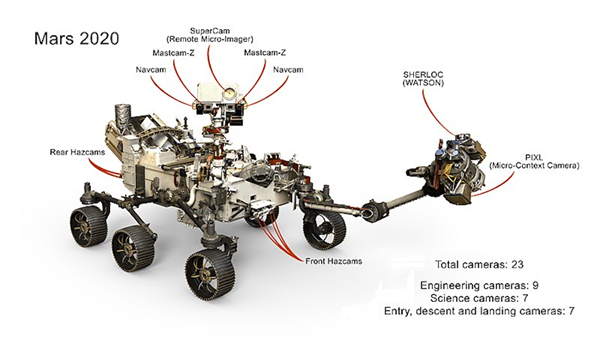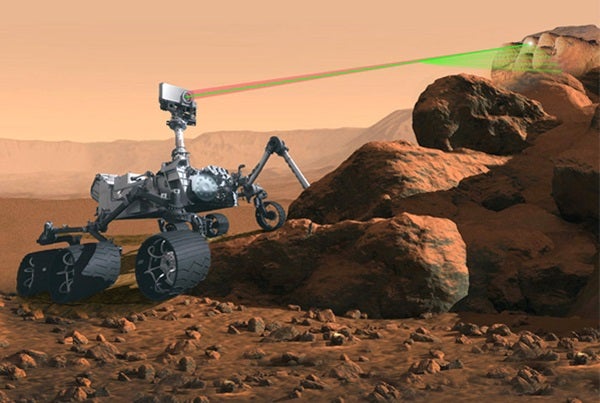My point is that camera technology has taken a quantum leap in a little over a decade. And this hopefully helps illuminate just how mediocre (by modern standards) the five cameras on NASA’s Mars Pathfinder were when it touched down on the red planet way back in 1997.
Because cameras have shrunk in size, increased in quality, and decreased in price over the years, NASA has decided that the rover for its Mars 2020 mission will be decked out with more cameras than any rover that has come before it. All together, the Mars 2020 rover will have 23 cameras that it will use to study the Martian atmosphere and soil, reveal potential hazards and obstacles, create sweeping panoramas, and much, much more.
In 2021, when the rover begins its initial descent into the Martian atmosphere, six entry, descent, and landing cameras will switch on to capture the first video of a rover’s parachute as it opens on another planet. And as Mars 2020 approaches the surface, it’s Lander Vision System Camera will process images of the planet’s terrain with an onboard computer, guiding the rover through its landing.
Once on the surface, the rover will begin to both gaze upward and dig downward. SkyCam, which you may have guessed is a sky-facing camera, is part of the rover’s suite of weather instruments designed to study the Martian clouds and atmosphere. On the other hand, CacheCam is embedded within the rover and will watch as it collects rock samples and deposits them for later analysis.
Jim Bell, principal investigator for Mars 2020’s Mastcam-Z, explained in a press release that the new rover will also have much better color and 3-D imaging capabilities than its predecessor, Curiosity. Mastcam-Z is a much more advanced version of Curiosity’s two-camera Mastcam, which served as the rover’s main eyes. The “Z” in Mastcam-Z refers to the fact that the upgraded camera has a 3x optical zoom built in. With it, Mars 2020 can take finely detailed images of the Martian surface from up to a football field away.
With Mastcam-Z’s stereoscopic cameras, it can also capture more 3-D images, which are ideal for spotting potential samples or geologic features — like erosion and soil texture — from long distances. “Routinely using 3-D images at high resolution could pay off in a big way,” Bell said. “They’re useful for both long-range and near-field science targets.”
That brings us to Mars 2020’s Enhanced Engineering Cameras, which are built to plan out driving routes (Navcams) and avoid hazards (Hazcams). Though the Spirit, Opportunity, and Curiosity rovers have all had engineering cameras, they only captured 1-megapixel, black-and-white images. On the new rover, these engineering cameras will snap high-resolution color images with a whopping 20-megapixels.
Furthermore, the new Enhanced Engineering Cameras will have a very wide field of view, revealing more of its surroundings so it can optimize how it spends its time. “Our previous Navcams would snap multiple pictures and stitch them together,” said Colin Mckinney, product delivery manager for the new engineering cameras. “With the wider field of view, we get the same perspective in one shot.” To further minimize downtime, the rover’s cameras will also automatically reduce motion blur, allowing it to take photos while on the move.
In order to handle the torrent of data these cameras will produce, researchers are focusing on two key issues: data compression and data relay.
Unlike Spirit and Opportunity, which compressed data using onboard computers, the more recent Curiosity rover used electronics within the camera itself to condense data before transmitting it back to Earth. This was a very efficient approach that researchers will implement again with Mars 2020.
To transmit that compressed data back to Earth for further analysis, NASA is planning to use existing spacecraft already in orbit around Mars as powerful relay stations. For the first two years of the Mars 2020 mission, the rover will beam its data up to either the Mars Reconnaissance Orbiter or the Trace Gas Orbiter before the signal is boosted and sent to Earth for analysis.
With 23 modern cameras, each designed to excel at a specific task, the Mars 2020 rover is destined to return some of the most fascinating images yet of the red planet. But, when you consider how far camera technology has come in the past decade, it’s extremely difficult not to look further into the future, and dream about the technology that will be available for Mars 2030.











